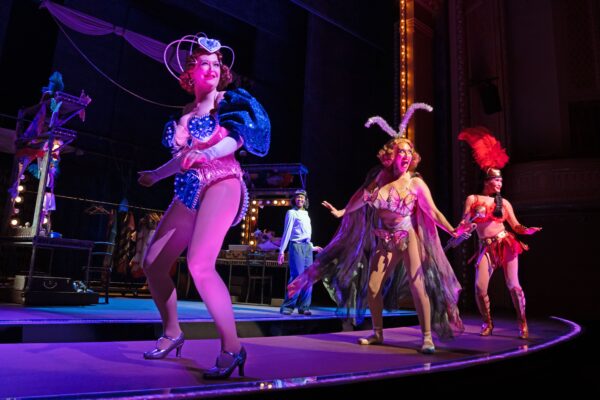Theater Review – Audra McDonald Dazzles as Mama Rose in a Star-Powered “Gypsy” Revival
By Christopher Caggiano
In a production filled with emotional intensity, Audra McDonald delivers a powerhouse portrayal that elevates a somewhat uneven staging.

Joy Woods & Audra McDonald in Gypsy. Photo: Julieta Cervantes
When it was announced that six-time Tony winner Audra McDonald would take on the role of Mama Rose in a Broadway revival of Gypsy, my initial reaction was a mix of excitement and skepticism: “Yay, Audra!” quickly followed by “But … isn’t she a soprano?”
However, Audra has proven time and again that she is a theatrical force capable of extraordinary feats. I just kept telling myself, “Audra can do anything. Audra can do anything…” But would she be able to truly master one of the most demanding roles in musical theater? The answer is yes — with a few caveats.
All doubts about whether Audra was right for the character faded from the moment she made that iconic march up the aisle and stormed on stage. Audra’s Rose is a true powerhouse, filled with relentless energy and sharp comic timing. Sure, occasionally, her portrayal hints at her recent turn as Billie Holiday in Lady Day at Emerson’s Bar & Grill. But rather than being distractions, these moments add complexity to Rose’s character, imbuing the role with both grit and vulnerability.
So, yeah. Audra can act the role of Rose. But can she sing it? Well, vocally, the role sits at a challenging place in McDonald’s range, frequently hovering at her break. While her mix of head and chest voice in “Some People” is masterful, her final “For me!” in “Rose’s Turn” lacks the climactic belt many might expect. (Well, that I expected.) We’re talking two of the most iconic notes in all of musical theater, and it was a genuine disappointment to hear them sung in head voice, no matter how strong and controlled.
But, again, Audra’s otherwise dynamic portrayal of Rose more than compensates, particularly in the Act I finale. As Rose hugs Louise to her during “Everything’s Coming Up Roses,” the hug quickly transforms into a full-on half Nelson, with Louise practically choking for air. The “Small World” reprise in Act II is another standout. Most Roses play this moment as resigned or wistful, but Audra’s raw sobs make Rose’s heartbreak painfully real.
Gypsy is often regarded — and rightly so — as one of the greatest musicals of all time, if not the greatest. Yet the show has always relied on star power to succeed. From Ethel Merman to Patti LuPone, each revival has been defined by its leading lady, to the point where it’s almost impossible to recast the role once the star decides to leave. It makes me wonder whether Gypsy could ever have a successful run without a star in the central role of Rose. (Well, maybe it might if we didn’t keep reviving it every five years…)

Mylinda Hull, Joy Woods, Lesli Margherita & Lili Thomas in Gypsy. Photo: Julieta Cervantes
The show’s iconic overture — arguably the best in all of musical theater — is a thrilling reminder of why this show endures. It’s a shame that modern audiences seem to have forgotten that overtures are actually part of the show and that they should really shut the hell up and listen. (Folks are performing here, people!)
George C. Wolfe’s direction here is a bit of a mixed bag. On one hand, he brought out exceptional nuance in the relationships among the main characters, particularly Rose and Herbie. Their dynamic was more layered than ever, with palpable moments of both easy humor and genuine physical attraction.
In particular, Wolfe’s staging of the aborted wedding scene, which transitions into Louise’s first strip as Gypsy Rose Lee, is visually striking and emotionally devastating. As Rose eagerly volunteers her daughter to step in for the missing star stripper and frantically begins to prepare for Louise’s burlesque debut, Louise sits numb staring into the middle distance while Herbie slowly trudges off upstage, defeated. It’s an arresting stage picture.
On the other hand, Wolfe seems to have given a bit too much leeway to some members of the supporting cast. Jordan Tyson as June is shrill, overplayed. Yeah, sure, June is a great big ham. But Tyson never tempers her exaggerated mugging, even when June is supposedly out of character. It was genuinely off-putting.
The rest of the cast is considerably more successful. Danny Burstein delivers a deeply sympathetic and layered performance as Herbie, building to an explosive climax in the wedding scene that left me reeling. Also, we can always count on Lesli Margherita for a fully-fledged characterization, and her loopy, jaded Tessie Tura is a major highlight.
Joy Woods as Louise excels in the role’s mousier moments but falters during the strip montage. This may be partly Wolfe’s doing, but Woods doesn’t really do justice to the wry humor and sharp physical punctuation that the scene requires.

Joy Woods & Kevin Csolak in Gypsy. Photo: Julieta Cervantes
As for Camille A. Brown’s choreography, I must confess a bias. As a devoted admirer of Jerome Robbins and his original choreography, I found this production’s dance a bit too jarring and anachronistic. Brown’s take on “All I Need Is the Girl” is especially disappointing. Robbins’s genius lay in his ability to use dance as an extension of character, and here, that essential storytelling is mostly absent. Tulsa’s dance feels too polished and lacks the scrappy charm — and stolen moves — that underscore his character’s amateur status.
Worse, the staging muffles Louise’s unspoken yearning for Tulsa, losing much of the scene’s emotional impact. In the Robbins staging, as Tulsa demonstrates his nightclub act to Louise, Tulsa does a lift with an imaginary partner while Louise is upstage mimicking his movements as though she were that partner. It’s heartbreaking. In this production, that nuance is reduced to a vague suggestion. So, for me, the scene fell flat, a missed opportunity to deepen Louise’s character arc.
There has been considerable discussion about the choice to bring together a predominantly African-American cast, director, and choreographer for this Gypsy revival. The intent was apparently to reframe the narrative through the lens of Black experiences in vaudeville, which is certainly admirable. However, this concept felt underexplored in the actual staging, with little to clearly connect the production to this perspective. Production concepts and dramaturgy are all well and good, but they really need to make themselves clear in the show itself, as opposed to directors’ notes or feature stories on theatrical websites.
This revival of Gypsy succeeds on the strength of Audra McDonald’s powerful performance and George C. Wolfe’s thoughtful exploration of its central relationships. While uneven supporting performances and missed opportunities hold the production back from perfection, the emotional intensity and sheer star power on display make this a Gypsy worth treasuring.
Christopher Caggiano is a freelance writer and editor living in Stamford, CT. He has written about theater for a variety of outlets, including TheaterMania.com, American Theatre, and Dramatics magazine. He also taught musical-theater history for 16 years and is working on numerous book projects based on his research.
Tagged: Audra McDonald, Camille A. Brown, Danny Burstein, George C. Wolfe, Gypsy, Jordan Tyson

Thank you for your incredibly perceptive review and the comment about overtures…”they should really shut the hell up and listen.” In my time at the Colonial (’70s and ’80s) even the the mid-week matinee subscription audiences who saw everything tucked their shopping bags away and (mostly) ended their chatter.
I saw Gypsy on May 16th. I was shocked that the audience talked over the iconic Jule Styne written Overture. They treated it as if it were a commercial before the main program. I was disgusted with this total disrespect of the artists and the theatre’s unwritten standards.
To quote Mama Morton, “The whole world’s gone lowbrow!”
Audra McDonald? low brow? you have never met, heard or seen Mrs. McDonald at all. the complaint with Gypsy is that her ” classically trained soprano” is to “High Brow” to ” sophisticated” For the ” go for broke” ” gutsy” ” belt” of Mama Rose. please stop using coded language
My comment was in response to the previous comment about bad behavior from audience members. It wasn’t in reference to Audra in the slightest. Check for context before you decide to vent.